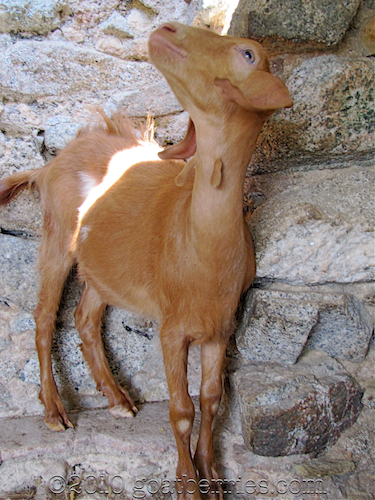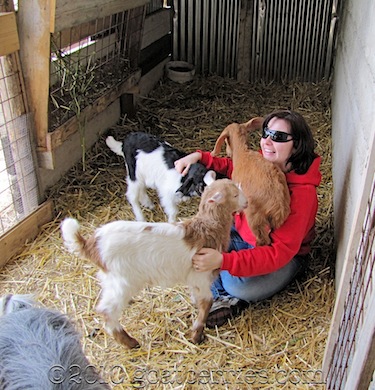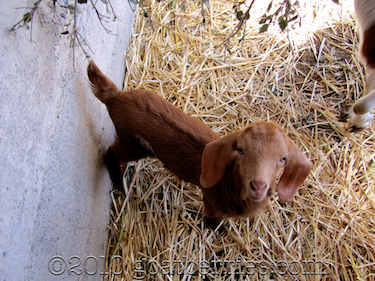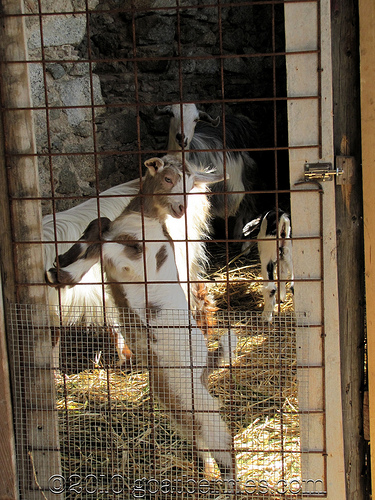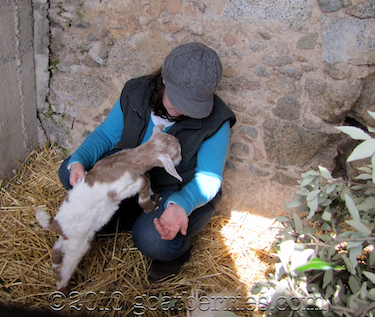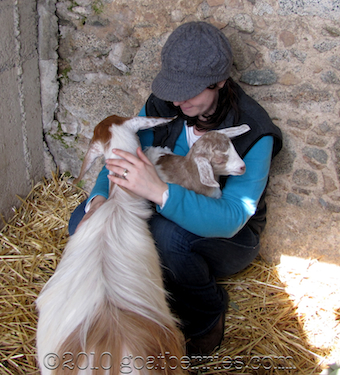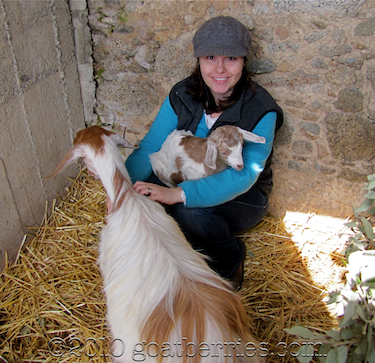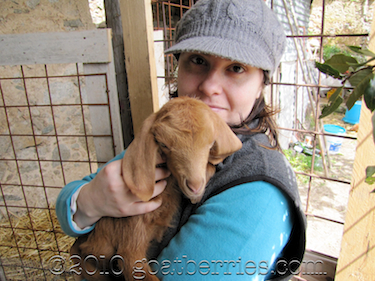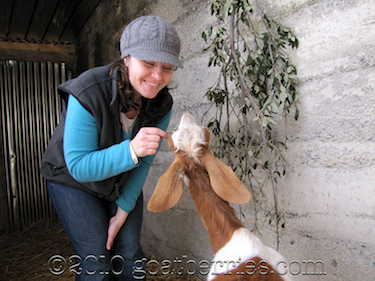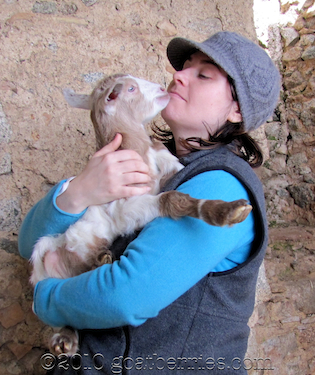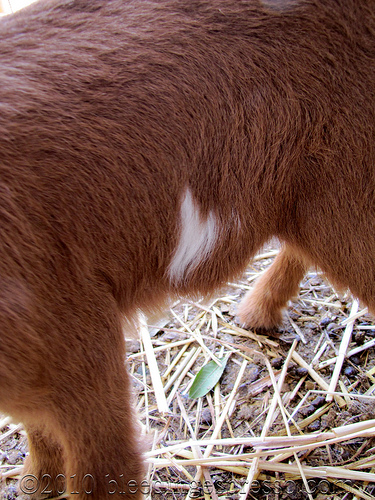Archive for the ‘Kidding’ Category
More Goat Questions Answered!
It’s time again to talk about some of the searches that have brought people to Goat Berries. Read previous entries at Answering Goat Questions: Part I and Part II.
As I mentioned before, goats and watermelons have been on a lot of goatie friends’ minds these days, but here’s what else they’ve been wondering about:
1. Goats fig leaves edible : I’m assuming this is asking whether goats can eat fig leaves. Mine have, although we were told by a an experienced goat herder here that they shouldn’t have too much, so we tend to give them to our girlies just when we’re pruning the fig trees a bit — they never get more than a few branches at a time, and that’s usually weeks or months apart.
2. Goats and pit fruit / can goats eat fruit with seeds/pits : They sure can, and many times they’ll just spit the pit out if they don’t want it. Pasqualina has spit out both apricot and plum pits. It’s *so* fun to watch them eat these as they roll them around in their mouths. That said, don’t give them too many at a time — just like our digestive systems don’t love too much of a good thing like apricots and plums, neither do theirs.
3. Can goats eat banana peelings? : Whoo boy, can they — and my girl Pasqualina *loves* them. Loves bananas too. The other does we had also loved both fruit and peel, but Pinta isn’t old enough to care yet, apparently. Again, though, everything in moderation!
4. Kid goat cries all the time / why does my goat cry : Dig if you will the pic-ture. Oh wait, that’s When Doves Cry. Anyway, this is a tough one and requires that you know your kid pretty well. Some kids are just loud and cry when they want attention or food or milk or all of the above. Generally it’s not a problem unless it sounds like the kid’s in pain.
Of course, my kid cries like she’s in pain when she’s bored, so even that’s not a reliable measure. Who her?
In short, I think the answer to the question is most likely the age-old one: because s/he can. But if the crying seems abnormal to you, do look for other signs of illness such as lack of appetite, bloating, and just otherwise not doing goat-like things.
5. Milky sticky discharge coming out of nanny goat before kidding : Gross, but totally normal. We noticed it on two of ours about 24 hours before kidding. The other one didn’t show anything, or maybe we just weren’t looking (she was the first to go). I actually have a photo of this, but I think you get the idea; if you want to see it though, please feel free to contact me. In any event, you’ll be having a kid or more *very* soon. Congratulations!
Remember if you have any goat questions that aren’t answered somewhere in the blog, don’t be afraid to ask! I can’t promise to know the answer, but I will be happy to put it out there to other goatie lovers if I don’t.
And please feel free to add your bleats of wisdom on the above questions as well!
Buon weekend!
Answering Goat Questions: Part II
Following up Answering Goat Questions: Part I, here is Part II:
6. “why do goats poop berries” – This has to do with the way their digestive system is set up (hint: nothing like ours) and what they eat, but you can read all about it at The Straight Dope.
7. “coffee discovered by goats” – Well, yes, kind of. Read all about it at The Legend of Coffee and the Dancing Goats.
8. “training goats” – Hah! Good luck with that. No, seriously, depends on the kind of training you want to do. Goats are highly intelligent, but they can also be stubborn. We’ve taught two of ours to walk on leashes. I don’t know about house-training, though…those little trap doors seem to open and drop a load of goat berries whenever they damn well please.
9. “who is pasqualina” – OK, I don’t know for sure that you were actually looking for *my* Pasqualina, but you can find lots of photos of her on Flickr, her kidding story on this site, and various posts about her at Bleeding Espresso.
P.S. She looks like this:
10. “michelle fabio” + paolo” – OK, pretty sure you were looking for us on this one. Congratulations! You are here.
That’s all until next time; thanks for finding us!
Answering Goat Questions: Part I
Those of you with websites know that far too much fun can be derived from looking through the search terms people used to find your site.
The searches for Goat Berries have been extra interesting to read as they let me know what fellow goat people want to know. I’ve noticed some questions I haven’t yet answered, so I’m going to answer some here (mostly about the kidding process) and then more in Part II, forthcoming:
1. “lover of goats in Italian” – Literally, it would be “l’amante delle capre,” but in Italian you’d more likely say someone is “appassionato (or appassionata if it’s a woman) delle capre.” It’s safe to say I’m one of those.
2. “should I separate goat when kidding” – Most things I read on the Internet and in books talk about kidding stalls to separate the mom from the rest of the herd when she’s about to give birth. In fact, we did separate out one of our moms because we thought she’d be more comfortable that way.
The other two of our dams, though, gave birth in the same pen with the other present (and one even had another kid present). Everything went fine, but I imagine this is something you get a feel for regarding specific goats and their preferences.
3. “goat how long after water sac birth” – When Pasqualina gave birth, her water broke, she had about two minutes of rest (if that), and then she started pushing. We had a kid within five minutes or so, with the whole birth taking not more than 15 minutes.
4. “goat kidding – fresh blood” – This is an interesting query. I actually expected more blood with the birth of the kids, but there really wasn’t any during the actual birth. Lots of goo, yes, but not blood.
The moms *did* however pass fresh blood the following day (usually in clots) and also for the following two weeks — *not* constant streams of blood by any means, just every once in a while. In sum, if you think you’re seeing too much blood, you probably are, so call a veterinarian. Better to err on the side of caution.
5. “what if the goat doesn’t deliver the placenta” – You could have yourself a problem here. A new goat mom should pass her placenta within 24 hours or so of giving birth, but if you weren’t watching the whole time, she may have eaten it. Or a dog may have eaten it, if it had access.
Our three goats all passed the placenta completely within two or three hours of giving birth (in all cases it started to come out almost immediately). If yours hasn’t done so after a whole day, you may have a “retained placenta” on your hands, and you should consult a veterinarian. Basically the vet is going to have to give her something to start contractions to get it out.
Stay tuned for more questions and answers in Part II!
Buon weekend!
Two Weeks and Counting
All of the kids are now two weeks old. Whoa.
It’s strange to think back to a time when we had no idea what they’d look like, how many of them were in the girls’ bellies, or even whether they’d make it through the birth OK. What a huge relief that all the births went well. I can’t stress that enough. I was *so* nervous and anxious reading all the horror stories on the Internet.
I hear pregnant women say things like that all the time–how reading information on pregnancy tends to scare you because it’s all the bad stuff that gets written about. Well, goat birth stories definitely did the same for me. Of course it’s nice to be prepared for the possibilities of complications, same as with human births, but still…it can really get your imagination working overtime. I had lots of really scary thoughts about having to deal with a breech birth or worse….
Anyway, can you do me a favor and tell me whether you think they’re growing?
It’s so hard to see the changes when you’re with them every day, but every now and again, you get a good glimpse like in this photo with Nina’s baby hooves up on the gate. Doesn’t she look enormous?!
One of the coolest things in the past two weeks has been seeing the difference in their confidence levels.
They used to stand on my lap with these shaky, wobbly legs. Now they love to use me as a springboard as they jump up and off my lap — sort of like mini-skateboarders with the way they’re starting to kick out their legs off to the side on the jump.
They also rather enjoy just boinging around the pen, off the walls, off whoever might be standing there videoing the whole thing. etc. YouTube wasn’t so kind on the quality of this video, but you can still get the point, I think.
It’s *so* easy to spend hours in there with them.
Goats, Kids, and Imprint Training
In the comments, Karen of Via Martina asked me about whether imprint training was as important for goats as it is for horses. I had no idea what imprint training even was, so I googled, of course. I soon learned that basically it’s getting the animal used to being around and handled by humans.
As it turns out, I apparently instinctively “imprinted” Pasqualina as a kid because I held her and caressed her from an early age — although not as early as you’d start with imprint training as she was already about a month old when she came to us. Still, she’s quite docile and cooperative whenever it’s time to trim her nails or give her a shot. Of course, so are the other two goats, and to my knowledge, they weren’t handled very much until they came to us (both already several months old), so who knows?
That said, Pasqualina is definitely the most affectionate of the three, and the most attached to us.
I did find information on goat imprinting, in particular, at the Howling Duck Ranch (great blog!), and as it turns out, I did a lot of those things with these kids naturally, except I waited until they were all dry after birth to begin touching them. Many people encourage drying off the kids with towels to help the dam, but the weather wasn’t cold, and the dams seemed to be getting the job done, so I just let them be. The kids also ate right away without intervention.
After that, I started entering the pen and just letting the kids come to me. Goats are naturally curious animals, so it doesn’t take much to get them interested. Your presence is plenty. Sitting on the ground is the equivalent of an engraved invitation.
Within minutes they started crawling all over me, and I just let them, giving them some petties now and again and talking to them in Goat Baby-ese (why yes, it *is* it’s own language!). After a little while, usually after they slipped on my leg, they’d just lay down for a while, and I’d pet, being sure to touch all parts from the tips of the ears to the tips of the hooves — just getting them used to my touch. We’ve been doing this for a few days, and it’s going well.
Now when I enter, it barely takes a squat to get at least one of them to come over — in this instance, Nina.
And of course, where there’s Nina, there’s Carmelina — always wondering what I’m doing with her baby.
Regarding petting the kids, my instinct told me that as the human, I should let the goat mother come and see what I’m doing while bonding with the little one; aside from it reassuring Mom that I’m helping her take care of the kid and not doing any harm, it’s really just the polite thing to do. I mean, she *did* do all the work.
And the pseudo-imprint training continues in the other pen as well; Pinta is still getting used to us (she’s a day and a half younger than Nina), and she doesn’t mind being held at all.
What you can’t see here is that Pasqualina was in between my legs as I held her baby.
Off-topic from the imprinting, but I just have to say: We’re lucky that all three of the dams are uber-attentive and are really taking excellent care of the kids. In fact, they’re so good, they deserve some special love themselves.
So, I suppose I was kind of imprint training the kids the whole time without even knowing it, and also, obviously, without following any kind of set schedule or checklist. My personal theory, based on our experience with Pasqualina and now with how these kids are responding, is that generally being there with the kid physically, petting, caressing, etc. from a young age will get that imprinting accomplished.
That, and a lot of love, of course.
Buon weekend!
(Colombo, by the way, was sleeping during the photo shoot, but Margherita and he are doing just fine as well.)
Love Thursday: Pinta’s Heart-Shaped Stain
I didn’t necessarily plan on bringing Love Thursday from Bleeding Espresso over here to Goat Berries, but then a little kid named Pinta was born, and I had no choice.
First, let me back up and assure you that I am *not* making the following story up or embellishing in any way. You can ask Paolo any time you see him, and he’ll confirm.
A few weeks before Pasqualina delivered, we were playing proud parents just gazing at her changing body from outside the pen. I looked at Paolo, pointed to Pasqualina, and very plainly said, “She’s going to have a kid with a heart shape on her side.”
I’ll admit, I had imagined the coloring the opposite, in which the kid now known as Pinta would be mostly white and have a reddish-brown heart, but do you see it?
I spotted it almost as soon as she was out of Pasqualina; indeed, it looked even more obvious when she was all wet and goopy.
I don’t know which came first, the thought or the heart, but what a special little Pinta we have here. I know Pasqualina thinks so too.
Happy Love Thursday everyone!
Hug a kid, would you?

